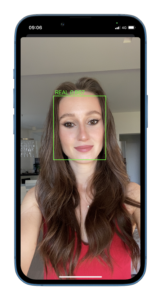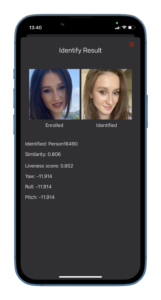KBY-AI’s Face Recognition algorithm was evaluated by NIST in the FRVT 1:1 assessment recently, so we are globally top-ranked by NIST in the FRVT leaderboards.
The KBY-AI’s Face Recognition SDK has achieved high ranking in NIST FRVT 1:1 benchmark due to its lightweight design and exceptional performance in accuracy, speed, storage, and memory
NIST(The National Institute of Standards and Technology) is a U.S. federal agency that develops and promotes standards, technology, and measurement tools to enhance innovation and industrial competitiveness. It plays a critical role in fostering advancements in science and technology in various fields.
Here, FRVT(The Face Recognition Vendor Test) is a program conducted by the National Institute of Standards and Technology (NIST) to evaluate the performance of facial recognition algorithms. It is considered a global benchmark for testing the accuracy, speed, scalability, and bias of face recognition technologies.
The SDK integrates easily into various platforms such as Android, iOS, Flutter, React-Native, Ionic Cordova, Web Server and it provides with a seamless user experience. It supports 1:1 and 1:N face matching functionalities with high accuracy.
KBY-AI ensures a True Positive Rate (TPR) > 95%, False Acceptance Rate (FAR) < 0.1%, False Rejection Rate (FRR) < 1%, and Equal Error Rate (EER) < 1.5% for their face recognition algorithm.
Introduction To FRVT Assessment For Face Recognition
The Face Recognition Vendor Test (FRVT) is a benchmark for evaluating face recognition technologies. Managed by the National Institute of Standards and Technology (NIST), FRVT provides a standardized framework to assess the performance, accuracy, and robustness of various face recognition algorithms. Over the years, it has become an essential reference for developers, vendors, and organizations involved in biometric research and applications.
What Is NIST?
The National Institute of Standards and Technology (NIST) is a U.S. government agency that develops and promotes measurement standards, technology, and best practices to enhance innovation, economic security, and quality of life. Established in 1901, it operates as part of the U.S. Department of Commerce and plays a critical role in ensuring technological progress and competitiveness in various industries.
Where does KBY-AI place on FRVT benchmark?
KBY-AI submitted their face recognition algorithm to NIST for global validation by a third party.
As a result, their face recognition algorithm was evaluated by NIST in the FRVT 1:1 assessment on December 20, 2024, achieving a top global ranking on the NIST FRVT leaderboards

Which role does FRVT assessment play for face recognition evaluation?
Face recognition technology has seen significant advancements, particularly in fields like security, authentication, and surveillance. However, with these advancements comes the need for rigorous testing and evaluation. FRVT plays a crucial role in ensuring that algorithms meet the required standards for real-world deployment.
One of the primary objectives of FRVT is to evaluate the accuracy of face recognition systems. Accuracy is assessed by measuring metrics such as false match rate (FMR) and false non-match rate (FNMR). These metrics provide insights into how well an algorithm can correctly match or differentiate between faces.
Another key aspect of FRVT is robustness testing. Algorithms are evaluated under varying conditions, such as changes in lighting, pose, aging, and occlusions. This ensures that the technology performs reliably across diverse scenarios.
The FRVT framework also examines speed and efficiency. In real-world applications, face recognition systems often need to process large datasets in real-time. By benchmarking processing times, FRVT helps developers optimize their algorithms for faster performance without compromising accuracy.
FRVT provides separate tracks for different applications, such as verification (1:1 matching) and identification (1:N matching). This allows developers to focus on specific use cases and improve their systems accordingly.
One notable feature of FRVT is its focus on large-scale testing. By evaluating algorithms on extensive datasets, the assessment provides a comprehensive understanding of their performance in real-world scenarios. This large-scale approach also helps identify potential weaknesses that might not be evident in smaller tests.
Participation in FRVT is open to organizations worldwide, fostering a competitive environment for innovation. Over time, this has led to significant improvements in face recognition technology, benefiting both industry and society.
For researchers and developers, FRVT serves as a valuable resource for understanding the strengths and limitations of their algorithms. By analyzing detailed performance reports, participants can identify areas for improvement and refine their solutions.
Government agencies and businesses often rely on FRVT results when selecting face recognition systems. The assessment provides a trusted benchmark that helps stakeholders make informed decisions about deploying biometric technologies.
The FRVT program is continually evolving to address emerging challenges in face recognition. For instance, recent assessments have focused on evaluating systems’ ability to detect deepfakes and other forms of digital manipulation.
While FRVT offers numerous benefits, participating in the assessment requires significant effort and resources. Developers must prepare their algorithms and ensure compliance with the test requirements, which can be time-consuming.
Despite these challenges, the value of FRVT cannot be overstated. By promoting transparency and accountability, the assessment contributes to the responsible development and deployment of face recognition technology.
Where Can Be Face Recognition SDK Run
The Face Recognition SDK provides robust features for smooth identification, delivering precise and efficient 1:1 and 1:N face matching performance. Here are the key features to build this SDK on several platform.
Multi-Platform Support
The KBY-AI’s face recognition SDK provides real-time face identification on the several platforms such as Android, iOS, Huawei, Sumsung, Windows and Linux. Mobile demo applications are already pushed to Google Play for customers to enjoy with ease and pushed to GitHub and GitLab repo for developers to check the code architecture easily.
Web server demo SDK has be wrapped as docker container and shared on dockerHub and GitHub for developers. Server SDK was deployed to KBY-AI‘s company online test page and HuggingFace spaces page.
Multi-Framework Support
The SDK has been built with multiple framworks in several programming languages like python, C/C++, C#, Java, Kotlin, Swift, Objective-C, Javascript and Dart.
The frameworks that can use KBY-AI’s SDK are as follows:
- Flutter (Android & iOS)
- React-Native (Android, iOS & Web)
- Ionic Cordova (Android & iOS)
- ReactJS (Web)
- Docker (Windows & Linux)
Multi-function Support
The SDK supports a lot of relevant functionalities. This includes:
- Face Detection
- Face Liveness Detection
- Pose Estimation
- Face Recognition
- Face Quality Calculation
- Face Occlusion Detection
- Eye Closure Detection
- Age, Gender Estimation
KBY-AI’s face recognition mobile SDK offers 3 package options for user convenience as outlined in the following table.
| Basic SDK | Standard SDK | Premium SDK |
|---|---|---|
| Face Detection | Face Detection | Face Detection |
| Face Liveness Detection | Face Liveness Detection | Face Liveness Detection |
| Pose Estimation | Pose Estimation | Pose Estimation |
| Face Recognition | Face Recognition | |
| 68 points Face Landmark Detection | ||
| Face Quality Calculation | ||
| Face Occlusion Detection | ||
| Eye Closure Detection | ||
| Age, Gender Estimation |
To access all three packages, please visit KBY-AI’s GitHub repository.


B2B Partnership On SDK Service
Face Recognition SDK can be provided with lifetime license and demo project resource so that customers(company or individual) can easily integrate the SDKs into their project. These benefits include enhanced security and B2B partnership for the SDKs which is leading by KBY-AI. Let’s dive into these benefits.
Providing Lifetime License
Security is crucial for any business. KBY-AI provides the customers with lifetime license for the Face Recognition SDK works fully offline and on-premises to support security:
- Lifetime license just indicates perpetual one to use SDK on the pre-defined device or machine permanently .
- License is for one-time payment.
- The SDK works in fully offline, on-premises and don’t require any internet connection for avoiding violation against privacy policy.
This helps businesses maintain a secure environment. It also builds trust with customers.
Continuous & Healthy Business Partnership
KBY-AI has the healthy and continuous business partnership with customers and it is gaining more customers from all over the world each day providing kindly business service. An Face Recognition SDK service by KBY-AI inlcude the following things:
- Applying so much discount in case of purchasing multiple license.
- Quick supporting professional technical problems which might happen on integrating SDK.
- Available on discussing with clients to provide the more perfect business service.
- Signing SLA(software license agreement or contract) to ensure the business with customers by putting the international and local law terms and conditions.
Businesses benefit from discount service workload. Customers appreciate a continuous and healthy business experience with KBY-AI.
FRVT Benchmark Detail With KBY-AI Face Recognition
The following diagram sheet screenshots are from the full FRVT results tables.



To view KBY-AI’s complete FRVT results table, please visit the following link.
The Engine Behind Face Recognition
Facial Recognition transforms how we verify identities. AI drives this cutting-edge tech. It makes passports more secure. Artificial Intelligence (AI) powers these systems, enhancing security and efficiency. Now, let’s explore how AI functions in this realm.
Machine Learning Algorithms In Action
Machine learning is AI’s brain. It recognizes faces among billions. It’s not magic but science and data. Here’s how it works:
- Pattern Recognition: AI spots unique facial features.
- Feature Analysis: It compares these features with vast datasets.
- Data Processing: AI uses powerful algorithms to process data fast.
- Instant Match: It finds the matching face in a sea of data.
Algorithms sift through complex data. They make facial recognition reliable and quick. AI doesn’t get tired. It doesn’t forget. It’s always on.
Training AI For Accurate Identification
Teaching AI to identify correctly is key. It’s like schooling a super-smart child. Here is what the training involves:
- Diverse Photos: AI studies millions of face photos.
- Iterative Learning: AI learns from its mistakes. It gets smarter over time.
- Consistent Updates: New data keeps AI learning.
When trained well, AI exceeds human accuracy. It can spot a face among millions, often more swiftly and precisely than humans. This makes passport control tighter, blocking fraud and speeding up queues.
The Future Of Face Recognition
Face recognition technology has made remarkable strides over the past few years, and it is clear that its potential for the future is vast. As we look ahead, we can expect to see even more advancements in accuracy, speed, and accessibility. One of the most exciting possibilities is the integration of artificial intelligence (AI) and machine learning to enhance face recognition systems, allowing them to work in increasingly complex environments.
In the coming years, we may witness face recognition being used in a broader range of applications, from personalized marketing and smart homes to healthcare and security. For example, healthcare systems could use face recognition to monitor patients and provide personalized treatment based on facial cues or expressions. Similarly, it could improve security by identifying individuals in crowded public spaces to prevent criminal activities.
Another area of growth is the blending of face recognition with other biometric technologies like fingerprint and iris scanning, creating multi-modal identification systems that offer more robust and secure verification methods. Moreover, the future of face recognition might involve less invasive methods, such as using low-resolution images or even recognizing faces from behind.
However, the widespread use of face recognition technology raises important ethical concerns. Issues related to privacy, consent, and potential misuse must be addressed to ensure that its adoption is done responsibly. Striking a balance between technological progress and ethical standards will be crucial in shaping the future of face recognition.
As society embraces these innovations, it will be important to regulate their use and establish clear guidelines to protect individuals’ rights. Overall, the future of face recognition looks promising, but it will require careful consideration to harness its full potential while safeguarding privacy.
Frequently Asked Questions
What Is NIST?
NIST(The National Institute of Standards and Technology) is a U.S. federal agency that develops and promotes standards, technology, and measurement tools to enhance innovation and industrial competitiveness. It plays a critical role in fostering advancements in science and technology in various fields.
What Is FRVT?
FRVT(The Face Recognition Vendor Test) is a program conducted by the National Institute of Standards and Technology (NIST) to evaluate the performance of facial recognition algorithms. It is considered a global benchmark for testing the accuracy, speed, scalability, and bias of face recognition technologies.
Where can I get KBY-AI’s FRVT result?
Please click here to get FRVT result for KBY-AI company.
How many request it can handle per second?
About 4~5 requests can be handled per second
Conclusion
In conclusion, the FRVT assessment is a cornerstone of progress in the field of face recognition. It not only drives innovation but also ensures that the technology is safe, reliable, and ethical. For anyone involved in biometrics, understanding FRVT is essential to staying at the forefront of this rapidly evolving domain.


